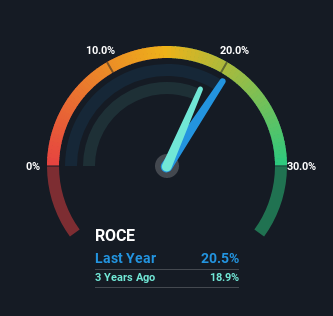- United Kingdom
- /
- Construction
- /
- LSE:CTO
TClarke (LON:CTO) Is Investing Its Capital With Increasing Efficiency
Finding a business that has the potential to grow substantially is not easy, but it is possible if we look at a few key financial metrics. Firstly, we'll want to see a proven return on capital employed (ROCE) that is increasing, and secondly, an expanding base of capital employed. Basically this means that a company has profitable initiatives that it can continue to reinvest in, which is a trait of a compounding machine. Speaking of which, we noticed some great changes in TClarke's (LON:CTO) returns on capital, so let's have a look.
What Is Return On Capital Employed (ROCE)?
Just to clarify if you're unsure, ROCE is a metric for evaluating how much pre-tax income (in percentage terms) a company earns on the capital invested in its business. To calculate this metric for TClarke, this is the formula:
Return on Capital Employed = Earnings Before Interest and Tax (EBIT) ÷ (Total Assets - Current Liabilities)
0.21 = UK£12m ÷ (UK£170m - UK£111m) (Based on the trailing twelve months to June 2022).
Thus, TClarke has an ROCE of 21%. In absolute terms that's a great return and it's even better than the Construction industry average of 8.7%.
See our latest analysis for TClarke

Above you can see how the current ROCE for TClarke compares to its prior returns on capital, but there's only so much you can tell from the past. If you'd like to see what analysts are forecasting going forward, you should check out our free report for TClarke.
What Can We Tell From TClarke's ROCE Trend?
The trends we've noticed at TClarke are quite reassuring. The numbers show that in the last five years, the returns generated on capital employed have grown considerably to 21%. The amount of capital employed has increased too, by 49%. So we're very much inspired by what we're seeing at TClarke thanks to its ability to profitably reinvest capital.
On a side note, TClarke's current liabilities are still rather high at 66% of total assets. This effectively means that suppliers (or short-term creditors) are funding a large portion of the business, so just be aware that this can introduce some elements of risk. While it's not necessarily a bad thing, it can be beneficial if this ratio is lower.
In Conclusion...
In summary, it's great to see that TClarke can compound returns by consistently reinvesting capital at increasing rates of return, because these are some of the key ingredients of those highly sought after multi-baggers. And a remarkable 110% total return over the last five years tells us that investors are expecting more good things to come in the future. In light of that, we think it's worth looking further into this stock because if TClarke can keep these trends up, it could have a bright future ahead.
One more thing: We've identified 3 warning signs with TClarke (at least 1 which is significant) , and understanding them would certainly be useful.
High returns are a key ingredient to strong performance, so check out our free list ofstocks earning high returns on equity with solid balance sheets.
Valuation is complex, but we're here to simplify it.
Discover if TClarke might be undervalued or overvalued with our detailed analysis, featuring fair value estimates, potential risks, dividends, insider trades, and its financial condition.
Access Free AnalysisHave feedback on this article? Concerned about the content? Get in touch with us directly. Alternatively, email editorial-team (at) simplywallst.com.
This article by Simply Wall St is general in nature. We provide commentary based on historical data and analyst forecasts only using an unbiased methodology and our articles are not intended to be financial advice. It does not constitute a recommendation to buy or sell any stock, and does not take account of your objectives, or your financial situation. We aim to bring you long-term focused analysis driven by fundamental data. Note that our analysis may not factor in the latest price-sensitive company announcements or qualitative material. Simply Wall St has no position in any stocks mentioned.
About LSE:CTO
TClarke
Engages in the design, installation, integration, and maintenance of the mechanical and electrical systems and technologies in the United Kingdom.
High growth potential with excellent balance sheet and pays a dividend.
Similar Companies
Market Insights
Community Narratives



